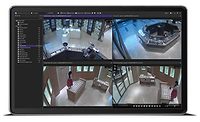Confirming and managing identities has a vital role in mitigating risk and addressing such wide-ranging challenges as physical and logical access control, insurance fraud, time and attendance records, and even ensuring a patient gets the right medication in a hospital. The more accurate the modality, the lower the risk, making accuracy the most critical element of identity verification technology.
Included in today’s generation of fast, highly accurate, non-contact identity verification technology are iris readers. Developed as a result of dedicated scientific research, faster processing power and improved image-capture technology, advanced iris reader technology delivers both enormous security improvements and business workflow innovation – at lower costs than ever before.
Setting the Record Straight
Surprisingly, there are still a few misconceptions about biometrics in general and iris readers in particular. Some facts and an explanation of how iris reader technology works might help to debunk some of these mistaken beliefs. First, remember that reading an iris is not a retina scan. The iris is the colored portion of the eye. The retina is back interior to the eye.
The iris pattern has the most desirable properties for verification compared to other biometrics because of its uniqueness, stability over time and relatively easy accessibility. It also has the highest accuracy among all biometrics – approximately 1,000 times more accurate than fingerprint sensors. An iris cannot be lent or stolen, and iris readers cannot be fooled by makeup, hair or clothing changes. Some can be read through eyeglasses, sunglasses, contact lenses, even in outdoor environments.
There is no “scan” involved in iris recognition; in fact it’s more akin to taking a selfie. To enroll a user, a video camera captures a detailed image of the iris and the system’s biometric software makes a template or “map” of the person's iris pattern for storage in the system. To verify identity later, an individual simply “looks into” the iris reader from a comfortable distance, and the system compares the patterns in the individual's iris against the templates stored in the database. If there's a match, the individual’s identity is verified. All of this takes less than one third of a second. And because no contact with the camera is required, either for enrollment or authentication, wear and tear on the cameras and contamination issues are greatly reduced.
Multiple Uses
Because of the non-contact interface – the user simply looks into the iris reader – the technology is often selected for applications where the user is gloved, such as in a pharmaceutical manufacturing, when hands may be dirty, such as a construction site or port, or in environments where users wear protective clothing.
As an identity management solution, iris readers have been deployed in environments as diverse as federal, state and local law enforcement, correctional facilities, travel and border security, healthcare, financial services as well as sports and entertainment venues, in addition to mainstream security locations.
Outside security applications, consider the efficiency and productivity gains for a workforce with the use of biometrics. In hourly and shift-based businesses such as retail, hospitality and manufacturing, time and attendance becomes more accurate (no more “buddy punching”) and automated. It also becomes more convenient, eliminating all the extra steps between punching in, recording hours, processing payroll and performing analytics.
Designs for Today and Tomorrow
The newest systems on the market offer a variety of capabilities for speed, accuracy and convenience. Some applications allow an individual to be recognized by the iris reader while moving through a checkpoint; others allow scanning of up to 30 people per minute from a distance of several feet. By comparison, expected throughput with high-end hand or fingerprint scanners is 10-15 people per minute.
Biometrics-embedded tablets combine the accuracy and convenience of iris biometrics with the functionality and customization of popular enterprise computing platforms. This enables one device to support workflows includingphysical access control, time and attendance, inventory control, company messaging as well as additional customizable applications. As an example, biometric-embedded tablets can make guard tours easier to track and monitor, and enhance data communications instantly in both directions.
Today’s iris readers are reliable, cost-feasible (particularly from a lifecycle cost perspective) and easy to use. With many organizations now giving more attention to managing risk, it’s easy to understand why iris readers are being implemented in growing numbers for the higher level of security provided and the added benefits they provide.



